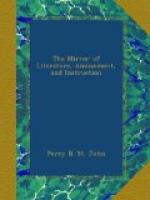JAMES HOGG.
* * * * *
NOTES OF A READER.
OLD DANCING.
An “Old Subscriber,” who loves a friend and a jest’s prosperity, has sent us a few leaves of “The Dancing Master,” printed in 1728, which form a curious contrast with Mr. Lindsay’s elegant treatise, printed at Mr. Clowes’s musical office. What will some of the quadrillers say to the following exquisite morsel of dancing, entitled, “The Old Maid in Tears?”—“Longways for as many as will".—(then the notes, and the following instructions:)—“Note: Each strain is to be play’d twice ov’er.—The first wo. holds her handkerchief on her face, and goes on the outside, below the 3d wo. and comes up the middle to her place; first man follows her (at the same time pointing and smiling at her) up to his place. First man do the same, only he beckons his wo. to him. First woman makes a motion of drying first one eye, then the other, and claps her hands one after another on her sides, (the first man looks surprizingly at her at the same time,) and turn her partner. First cu. move with two slow steps down the middle and back again. The first cu. sett and cast off.”
As we love to keep up the dance, if we are not leading the reader a dance, we give A Dance in Hoops, as described in a fashionable novel, just published:—
When the whole party was put in motion, but little trace of a regular dance remained; all was a perfect maze, and the cutting in and out (as the fraternity of the whip would phrase it) of these cumbrous machines presented to the mind only the figure of a most formidable affray.




